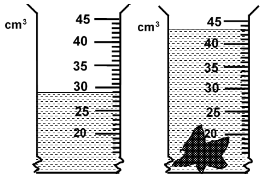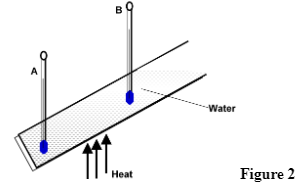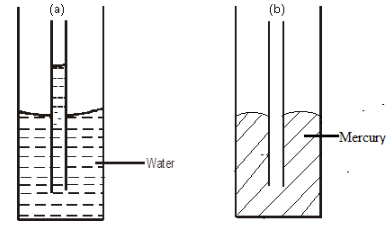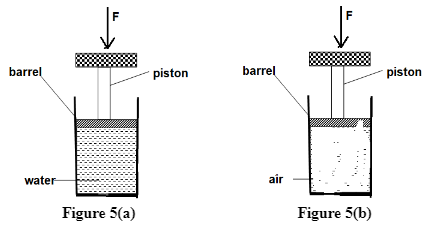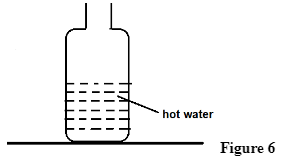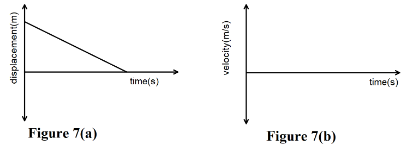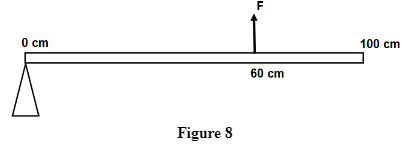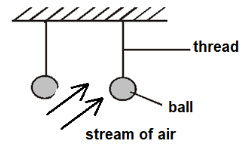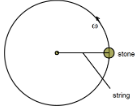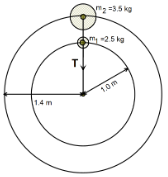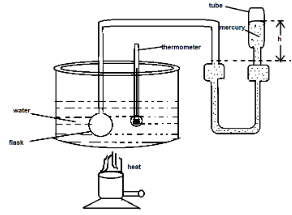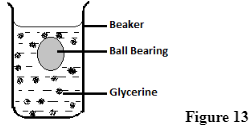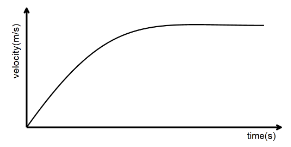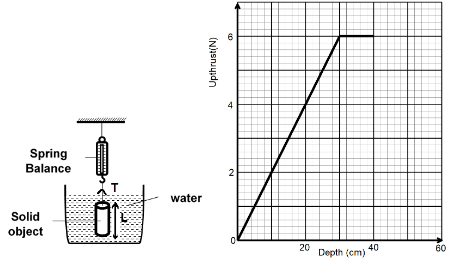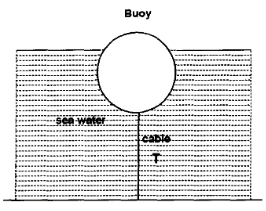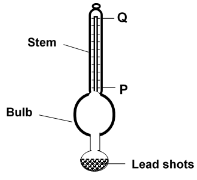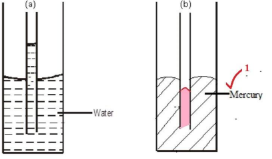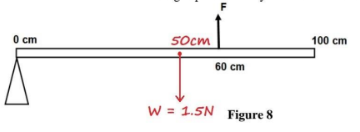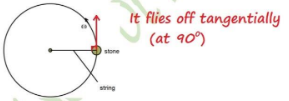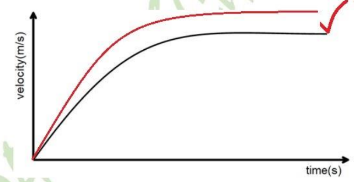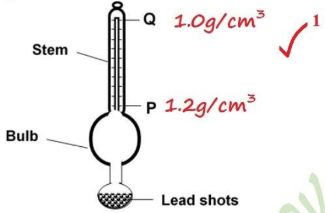Instructions to Candidates
- This paper consist of TWO sections; A and B. Answer ALL the questions in section A and B in the spaces provided.
- ALL working MUST be clearly shown. Mathematical tables, electronic calculators and slide rules may be used.
- Take: density of water = 1gcm−3, g =10Nkg−1
SECTION A (25 MARKS)
Attempt all questions in this section in the spaces provided
- Figure 1(a) and (b) shows the change in volume of a liquid in a measuring cylinder when an irregular solid is immersed in it.
Figure 1(a) Figure 1(b)
Given that the mass of the solid is 21.0 g, determine the density of the solid (2 marks) - Figure 2 shows a glass tube with water fitted with two identical thermometers A and B. It is heated as shown.
State with reason which of the two thermometers shows a higher temperature. (2 marks) - Two identical samples of bromine vapor are placed in identical gas jars A and B. A has some air in it and B is a vacuum. State with a reason which sample diffuses sooner. (2 marks)
- Figure 3 shows a clinical thermometer which is not graduated.
- Name the part indicated with letter X …………………………………………. (1 mark)
- State the function of the part labeled Y. (1 mark)
- Figure 4 (a) shows a capillary tube immersed in water.
Figure 4
Using figure 4(b), sketch to show the appearance of the mercury level in the capillary tube if it was inserted in mercury assuming equal diameters of the tubes (1 mark) - An oil drop has a diameter of 0.05cm. It forms a circular oil film of diameter 20cm when dropped on the surface of water. Determine the thickness of the molecule. (3 marks)
- State one factor that determine the spring constant of a helical spring. (1 mark)
- Figure 5(a) shows water enclosed by a piston in a cylinder while figure 5(b) show air enclosed by an identical piston in a cylinder
Equal inward force F is applied on the piston of the two cylinders. Giving reason, state the piston that moves in more. (2 marks) - Figure 6 shows a bottle containing hot water.
Explain how the stability of the bottle changes as water cools to room temperature (2 marks) - Waves are a branch of physics. State what it deals with (1 mark)
-
- A car undergoes uniform retardation to rest from 10m/s covering a distance of 25m. Determine its deceleration (2 marks)
- Figure 7 (a) shows a displacement time graph for the motion of a particle
On the axes in figure 7 (b) sketch a velocity time graph for the same motion (1 mark)
- A uniform meter rule of mass 150 g is pivoted freely at the 0 cm as shown in figure 8
Determine the value of the force F needed to ensure that the rule has horizontal equilibrium (2 marks) - Figure 9 shows two balls suspended from threads a short distance apart.
A stream of air is blown between the balls in a horizontal direction. Explain what is observed. (2 marks)
SECTION B (55 MARKS)
Answer ALL the questions in this Section
-
- Define the term centripetal force (1 mark)
- When a car is traveling on a mud road, mud flies off the fast spinning wheels, Explain this observation (1 mark)
- Figure 10 shows the path of a stone attached to a string whirled in a space in a horizontal circle.
Figure 10
Sketch on the diagram the path the body follows if the string breaks when the body is at the position shown. (1 mark) - Two masses m1 = 2,5kg and m2 = 3.5kg are connected by alight string and are in uniform circular motion on a horizontal frictionless surface as shown in figure 11. The masses describe circles of radii r1 = 1.0m and r2 = 1.4mrespectively and the angular velocity of the masses is 5.0rads−1.
Figure 11- Which of the two masses is moving faster? Give a reason for your answer.(2 marks)
- Determine the:
- Centripetal force on m1 (2 marks)
- Centripetal force on m2 (2 marks)
- The tension T on the string (2 marks)
-
- What is meant by the term specific latent heat of vaporization. (1 mark)
- In an experiment to determine the specific latent heat of vaporization of water, steam at 100°C was passed into water contained in a well lagged copper calorimeter. The following measurements were made.
Mass of calorimeter =50 g
Initial mass of water =70 g
Final mass of calorimeter + water + condensed steam = 123 g
Initial temperature of water + calorimeter = 5°C
Final temperature of mixture = 30°C
(Specific heat capacity of water = 4200Jkg-1K-1and specific heat capacity of copper = 390 Jkg-1K-1)
Determine:- Mass of the condensed steam. (2 marks)
- Heat gained by calorimeter and water (3 marks)
- Given that Lv is the specific latent heat of vaporization of steam
- Write a simplified expression for the heat given out by steam. (2 marks)
- Determine the value of (3 marks)
-
- Figure 12 shows a set-up which may be used to verify one of the gas laws
Figure 12- State the law which the set-up may be used to verify (1 mark)
- Name two measurements that should be taken in order to verify the law stared in (i) above (2 marks)
- Explain how the set-up can used to verify the law named in (i) above. (3 marks)
- A gas occupies 3m3 at a temperature of 27°C at normal atmospheric pressure. Determine its volume at the same pressure if the temperature is increased to 80°C (3 marks)
- Figure 12 shows a set-up which may be used to verify one of the gas laws
-
- State the law of conservation of linear momentum. (1 mark)
- Distinguish between elastic and inelastic collision. (1 mark)
- A lorry of mass 2000kg traveling at 20m/s collides with a car of mass 800kg traveling at 30m/s in the opposite direction. The impact takes 2 seconds before the two bodies move with a common velocity.
Determine:- The common velocity (3 marks)
- The impulsive force (2 marks)
- Figure 13 shows a ball bearing falling through glycerin
- Name the TWO forces acting on the ball bearing. (2 marks)
- Write down an equation relating all the forces in (i) above when the ball bearing attains a constant velocity. (1 mark)
- The graph in figure 14 shows the motion of the ball bearing through the above liquid.
Figure 14
On the same axes above sketch the graph to represent the motion of the ball bearing through alcohol. (1 mark)
-
- Figure 15(a) shows a solid object being lowered into a jar full of water and figure 15(b) the subsequent upthrust-depth graph as it is immersed in water. The tension of the string when the block is fully immersed is 3.0 N
Figure 15(a) Figure 15(b)
Determine the:- Length, L of the object …………………………………………… (1 mark)
- Upthrust U when the object is fully immersed in water ………………...… (1 mark)
- Weight W of the object (2 marks)
- Density of the object (2 marks)
- Figure 16 shows a buoy, B, of volume 40 litres and mass 10 kg. It is held in position in sea water of density 1.04 gcm-3 by a light cable fixed to the bottom so that ¾ of the volume of the buoy is below the surface of the sea water.
Figure 16
Determine:- Upthrust on the buoy (3 marks)
- The tension T in the cable. (1 mark)
- Figure 17 shows a diagram of a hydrometer which is suitable for measuring the densities of liquids varying between 1.0gcm−3 and 1.2gcm−3
Figure 17- State the reason why the bulb is wide. (1 mark)
- State the purpose of the lead shots in the glass bulb (1 mark)
- On the diagram indicate the label corresponding to and (1 mark)
- Figure 15(a) shows a solid object being lowered into a jar full of water and figure 15(b) the subsequent upthrust-depth graph as it is immersed in water. The tension of the string when the block is fully immersed is 3.0 N
MARKING SCHEME
- Volume = 43 − 29 = 14cm3
mass = 21.0g
density = 21/14 ✓1
=1.5g/cm3 ✓1 -
- B ✓1
- Convection currents travel upwards, (water is a poor conductor of heat). ✓1
-
- B ✓1
- There are no particles which collide with the bromine molecules to slow them down. ✓1
-
- bulb ✓1
- Prevent backflow of mercury into the bulb before the temperature is recorded. ✓1
-
- t = V/A ✓1 = 4/3 × π × (0.025)3 ✓1
π × 102
= 2.083 × 10−7cm ✓1 -
- Diameter of the spring
- Diameter/thickness of the wire
- Number of turns per unit length
- Length of spring
- Material of the spring
- Fig(b) ✓1 air is more compresssible ✓1 than water.
- Stability increases✓1/more stable, water contracts on cooling; lowering the position of c.o.g ✓1
- Study of propagation of energy through space. ✓1
- v2 = u2 + 2as
O = 102 + 2 × 25 × + a ✓1
O = 100 + 50a
⇒ a = −100
150
⇒ a = −2m/s2 ✓1 -
- v2 = u2 + 2as
-
F1d1 = F2d2
1.5 × 50/100 = F × 60/100
⇒ 1.5 × 50 ✓1
60
= 1.25N ✓1 - Balls move towards each other ✓1, the velocity of air increases between the balls lowering pressure. The higher atmospheric pressure on either side causes the balls to move towards each other. ✓1
-
- A force that constrains bodies to move in a circular path, and is directed towards the centre of the path.
- The achesive force between the wheels mand the nud is now not enough to provide the centripetal force, (required to make the mud move in the circular path, hence flies off tangentially.
-
-
- v = rω
m2 has a larger radius since linear velocity is directly proportional to radius at constant angular velocity -
- Fe = mrω2 ✓1
= 2.5 × 1 × 52
= 62.5N ✓1 - Fe = mrω2 ✓1
= 3.5 × 1.4 × 52
= 122.5N ✓1 - T = 62.5 + 122.5 ✓1
= 185N ✓1
- Fe = mrω2 ✓1
- v = rω
-
- Quantity of heat (energy) required to change a unit mass of a substance from liquid to vapour at constant temperature. ✓1
-
- 123 − (50 + 70) ✓1
= 3g ✓1 - Q = McCcΔθ + MwCw Δθ ✓1
⇒ Q = ( 50 × 390 × 25) + 70 × 4200 × 25) ✓1
1000 1000
= 487.mcθ5 + 7350
= 7837.5J ✓1 -
- Q = mcθ + mLv
= ( 3 × 4200 × 70) + 3 × Lv ✓1
1000 1000
⇒ Q = 882 + 0.003Lv ✓1 - Heat given out by steam = Heat gained by water & calorimeter
⇒ 882 + v0.003Lv = 7837.5 ✓1
⇒ 0.003Lv = 6955.5
Lv = 6955.5
0.003
= 2318500J/kg ✓1
- Q = mcθ + mLv
- 123 − (50 + 70) ✓1
-
-
- (pressure law) The pressure of a fixed mass of a gas is directly proportional to its absolute temperature at constant volume. ✓1
-
- Temperature ✓1
- Length of the mercury in the tube. ✓1
-
- The intial temperatures of the water both and the corresponding lengths are tabulated. ✓1
- The water is heated and several temperature and corresponding lengths are tabulated. ✓1
- A graph of pressure of mercury against temperature in Kelvin is plotted. ✓1
- The graph is a straight line through the origin.
- V1 = V2 ✓1
T1 T2
3 = V2
300 353
V2 = 3 × 353 ✓1
300
= 3.53m3 ✓1
-
-
- For a system of colliding bodies, total linear momentum remains constant provided no external force acts. ✓1
- Elastic collision is where both linear momentum and kinetic energy are conserved, while inelastic collision is where only linear momentum is conserved. ✓1
-
- m1u1 = m2u2 = (m1 + m2)Vc ✓1
(200 × 20) + (800 × −30) = 2800Vc
Vc = 16000 ✓1
2800
= 5.714m/s ✓1 - Ft = mv − mu
F = (2000 × 5.714) ✓1 − (2000 × 20)
2
= − 28572 F = −14286N ✓1
2
OR
F = (800 × 5.714) − (800 × −30)
2
F = 14286N
- m1u1 = m2u2 = (m1 + m2)Vc ✓1
-
-
- weight ✓1
- upthrust ✓1
- viscous drag/friction
- W = u + F ✓1
-
Alcohol has less viscous drag/friction, hence the body attains a higher terminal velocity than in glycerine.
-
-
-
- 30cm ✓1
- 6N ✓1
- w = T + U
= 3 + 6 ✓1
= 9N ✓1 - u = vpg
⇒ v = u
pg
= 6 × 10
1000
= 6 × 10−4m3 ✓1
Pobject = 0.9
6 × 10−4
= 1500kg/m3 ✓1
-
- u = pvg ✓1
= ¾ × 40 × 10−3 × 1040 × 10 ✓1
= 312N ✓1 - T = U − W
= 312 − 100 = 212N ✓1
- u = pvg ✓1
-
- To displace a larger volume of the liquid to provide sufficient upthrust to keep it floating. ✓1
- To keep the hygrometer floating,✓1
-
-
Download Physics Paper 1 Questions and Answers - Maranda High School Mock Exams 2023.
Tap Here to Download for 50/-
Get on WhatsApp for 50/-
Why download?
- ✔ To read offline at any time.
- ✔ To Print at your convenience
- ✔ Share Easily with Friends / Students

